Scientists find corals in deeper waters under stress too

Coral reefs around the world are threatened by warming ocean temperatures, a major driver of coral bleaching. Scientists routinely use sea-surface temperature data collected by satellites to predict the temperature-driven stress on reef communities, but new research shows that surface measurements alone may not accurately predict the full extent of thermal stress on deeper corals.
A new study led by scientists at Scripps Institution of Oceanography at the University of California San Diego and the Coral Reef Research Foundation (CRRF) in Palau describes a novel approach for predicting warm temperature-induced stress on corals from the sea surface through a deeper expanse ranging from 30-150 meters (100-500 feet) known as the mesophotic zone.
Corals at this depth are thought of by some in the science community as being safer from ocean warming than their shallow-water counterparts. But the Scripps Oceanography team found that even in the deep, corals are episodically exposed to thermal stress at intervals different than those corals near the surface.
The researchers utilized nearly two decades of data sets—including sea level, sea-surface temperature, and temperature observations that ranged between the surface and deep into the mesophotic zone—to develop a forecast tool for the vertical extent of how corals will be stressed by temperature. This research was conducted at three reef locations around the island nation of Palau, located in the tropical Pacific Ocean.
This novel approach to measure and predict temperature stress on coral reefs is described in a new study published Aug. 27 in the journal Geophysical Research Letters.
"We're now adding the dimension of depth into the problem where before we were only skimming the surface of what temperature stress meant for corals," said Scripps Ph.D. candidate Travis Schramek, lead author of the study. "We see that the heat-induced stress penetrates all the way into the mesophotic zone during larger bleaching events."
In addition to looking at sea-surface temperature data collected by global satellites, the scientists used a network of reef temperature recorders maintained by CRRF divers in key locations across Palau down to depths of 90 meters (295 feet).
CRRF has maintained this array of temperature gauges across Palau, stretching from the surface to the mesophotic reefs since 1999. Only a small number of divers in the world possess the training, skills, and equipment to safely and routinely dive in the mesophotic zone. One of these rare scientific divers is Pat Colin, director of CRRF and a coauthor of the study.
For nearly 20 years, Colin and a small team have conducted weekly dives at locations across Palau as part of a long-term temperature-monitoring program. Surveys to assess bleaching in the mesophotic zone are severely limited, so the Scripps team, which included scientists Mark Merrifield and Eric Terrill, found Colin's observational data sets to be incredibly valuable.
The observations showed that deeper zones are showing bleaching coincident with the higher temperatures, right along with shallow reefs.
"Our understanding of the ocean is really going to continue to be driven by observations. The models are really informative, but the way that we ground them is through observing the Earth system," said Schramek. "Having observations like what Pat has collected shows the power of actually going and deploying tools and observing Earth in a unique way."
The researchers said they hope these results will instigate more temperature stress event surveys to better understand the mesophotic zone in Palau and other tropical regions. They also looked at daily tide gauge records from the Malakal Harbor station in Palau from 1970-2017. This data, collected by the University of Hawaii Sea Level Center, allowed the team to study the regional sea level records in the area.

By coupling sea level and sea temperature data sets, Schramek found that the height of the ocean surface is a strong indicator of how water temperatures are changing tens of meters below. He and the team then further used this data to predict the temperatures experienced by coral reefs living near the surface, as well as those living in deeper waters. Schramek developed an algorithm to apply the accepted coral stress algorithms to depths that included the deeper mesophotic, typically thought to be a refuge from thermal stress.
"A surprising outcome of the study is that the oceanic conditions along the dramatic reef walls that are the boundaries of Palau are very representative of the broader Western Pacific," said Scripps oceanographer Terrill. "As a result, we had a surprising amount of success in predicting the vertical structure of the temperature fields that the coral communities would be exposed to, even during El Niño conditions."
He added that the results suggest promise in applying the method to the other islands in this Pacific region that don't benefit from the long-term time records that Palau has as a result of CRRF's dedicated measurement campaign.
The team's new insights on how to predict temperature stress on deep corals may contribute to a better understanding of the entire reef system as a whole, which could inform conservation and policy efforts to protect this valuable and diverse ecosystem.
"Now that we've observed this ecosystem in a unique way, we can start to better assess how corals in the mesophotic zone are stressed," said Schramek. "If we can better understand how they're stressed, then we can better understand how to protect them."
More information: Geophysical Research Letters (2018). agupubs.onlinelibrary.wiley.co … 10.1029/2018GL078782
Journal information: Geophysical Research Letters
Provided by University of California - San Diego



















